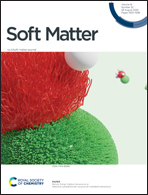Viscoelastic tribopairs in dry and lubricated sliding friction†
Abstract
Soft contacts present different tribological responses compared to stiff materials, especially when soft materials exhibit viscoelastic behaviour, as viscoelastic materials have intermediate mechanical properties between viscous liquids and elastic solids. In this work, we investigated the influence of viscoelasticity of soft materials on sliding friction in dry and lubricated conditions. To achieve this, soft tribopairs with varying viscoelasticity were obtained by tuning the weight ratios of polydimethylsiloxane (PDMS) base and curing agent. The real-time friction force and preload were observed over multiple conditions, with systematic control of lubricant viscosity, preload, and sliding velocity. Tribopairs with a higher proportion of viscous character had more oscilliations in the friction force. They also presented a higher friction coefficient due to the increased contribution of viscoelastic hysteresis losses on friction. Through regression analysis, the models of the friction coefficient were found, which are in good agreement with experimental results. From the models, we found that in both dry and lubricated conditions, viscoelasticity of tribopairs, indicated as the loss modulus or loss tangent, plays a key role in determining the friction coefficient. This influence is particularly significant for dry contacts due to the direct interactions between surfaces of tribopairs. This study provides empirical proof and a focused analysis on the role of viscoelasticity in tribological contacts.



 Please wait while we load your content...
Please wait while we load your content...